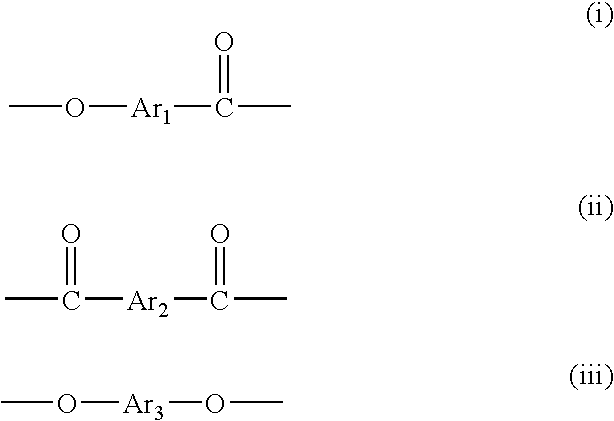Liquid crystalline polyester and molded article thereof
a technology of liquid crystalline polyester and molded articles, which is applied in the direction of luminescent compositions, thermoelectric devices, chemistry apparatus and processes, etc., can solve the problems of resin compositions not having satisfactory adaptability to strands, method is not suited for mass production and industrial production, and the composition may not be stably obtained. , to achieve the effect of low dielectric dissipation factor and high dielectric property
- Summary
- Abstract
- Description
- Claims
- Application Information
AI Technical Summary
Benefits of technology
Problems solved by technology
Method used
Image
Examples
synthesis example 1
[0087]In a reactor equipped with a stirrer, a torque meter, a nitrogen gas introducing tube, a thermometer and a reflux condenser, 1034.99 g (5.5 mol) of 2-hydroxy-6-naphthoic acid, 272.52 g (2.475 mol, 0.225 mol excess charge) of hydroquinone, 378.33 g (1.75 mol) of 2,6-naphthalenedicarboxylic acid, 83.07 g (0.5 mol) of terephthalic acid, 1226.87 g (12.0 mol) of acetic anhydride and 0.17 g of 1-methylimidazole as a catalyst were charged, followed by stirring at room temperature for 15 minutes, and then, the temperature was raised while stirring. After the inner temperature reached 145° C., stirring was conducted for 1 hour while maintaining at the same temperature.
[0088]While the distillate of by-product acetic acid and unreacted acetic anhydride were distilled off, the temperature was raised from 145° C. to 310° C. over 3 hours and 30 minutes. After maintaining at the same temperature for 3 hours, a liquid crystalline polyester was obtained. The resultant liquid crystalline polyes...
synthesis example 2
[0090]The prepolymer 1 obtained in Synthesis Example 1 was heated from 25° C. to 250° C. over 1 hour, heated from the same temperature to 293° C. over 5 hours and then subjected to solid phase polymerization by maintaining at the same temperature for hours. After the solid phase polymerization, the resultant material was cooled to thus obtain a liquid crystalline polyester in the form of a powder. The resultant liquid crystalline polyester is referred to as LCP1. With respect to LCP1, the flow initiation temperature was measured using a flow tester. As a result, it was 317° C.
synthesis example 3
[0091]The prepolymer 1 obtained in Synthesis Example 1 was heated from 25° C. to 250° C. over 1 hour, heated from the same temperature to 310° C. over 10 hours and then subjected to solid phase polymerization by maintaining at the same temperature for 5 hours. After the solid phase polymerization, the resultant material was cooled to thus obtain a liquid crystalline polyester in the form of a powder. The resultant liquid crystalline polyester is referred to as LCP2. With respect to LCP2, the flow initiation temperature was measured using a flow tester. As a result, it was 333° C.
[0092]Regarding LCP1 and LCP2 obtained in Synthesis Examples 1 to 3, the copolymerization molar fraction is determined from the molar ratio of the monomers used. As a result, the ratio of structural unit (i):structural unit (ii):structural unit (iii) is 55.0% by mol:22.5% by mol:22.5% by mol. The content of 2,6-naphthalenediyl groups is 72.5% by mol based on the total of all aromatic groups.
PUM
| Property | Measurement | Unit |
|---|---|---|
| Temperature | aaaaa | aaaaa |
| Temperature | aaaaa | aaaaa |
| Mass | aaaaa | aaaaa |
Abstract
Description
Claims
Application Information
 Login to View More
Login to View More - R&D
- Intellectual Property
- Life Sciences
- Materials
- Tech Scout
- Unparalleled Data Quality
- Higher Quality Content
- 60% Fewer Hallucinations
Browse by: Latest US Patents, China's latest patents, Technical Efficacy Thesaurus, Application Domain, Technology Topic, Popular Technical Reports.
© 2025 PatSnap. All rights reserved.Legal|Privacy policy|Modern Slavery Act Transparency Statement|Sitemap|About US| Contact US: help@patsnap.com



